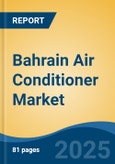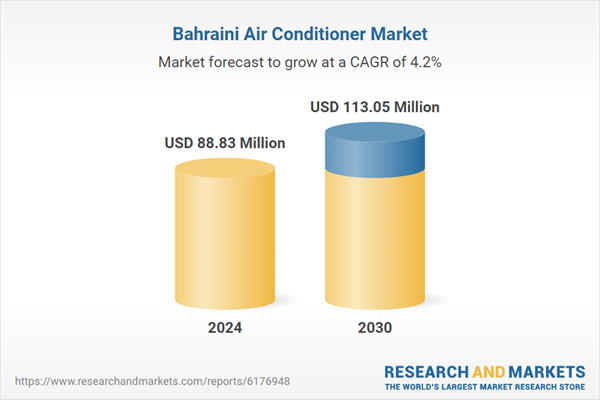Speak directly to the analyst to clarify any post sales queries you may have.
10% Free customizationThis report comes with 10% free customization, enabling you to add data that meets your specific business needs.
Meanwhile, According to a 2023 report, Bahrain’s tourism sector witnessed strong growth, with a more than 50% surge in visitor numbers and nearly USD 2.5 billion in revenue generated during the first half of the year. This robust expansion is significantly contributing to the growth of the air conditioner market. The influx of tourists has driven demand for new hotels, resorts, shopping malls, entertainment venues, and transport hubs - each requiring efficient and large-scale cooling solutions. To maintain comfortable indoor environments for visitors, the hospitality and commercial sectors are increasingly investing in modern air conditioning systems, boosting both installation and replacement activity across the country.
Key Market Drivers
Hot and Humid Climate Conditions
Bahrain endures extended, intensely hot summers marked by high humidity, making air conditioning a basic necessity rather than a luxury. Summer temperatures often exceed 40°C (104°F), while humidity levels frequently climb as high as 90%, largely due to the nation’s island location and proximity to the Arabian Gulf. To meet this soaring demand, Bahrain’s air conditioner imports surged in the first half of 2024: a total of 66,760 units an 8.6% increase year on year, led by strong demand and rising construction activity.These extreme climatic conditions drive strong demand for efficient and dependable air conditioning systems across residential, commercial, and industrial settings. With prolonged usage required for much of the year, air conditioners are vital in homes, offices, retail environments, and healthcare facilities. Additionally, the need for temperature control in vehicles, public infrastructure, and industrial operations further contributes to overall demand. This ongoing climatic pressure has fueled consistent growth in AC installations, stimulating both new purchases and replacement of older units with models that offer superior cooling and energy efficiency.
Key Market Challenges
High Energy Consumption and Grid Pressure
One of the most significant challenges in the Bahrain air conditioner market is the high energy consumption associated with widespread AC usage. Due to the country’s extreme climate, air conditioners operate for extended periods throughout the year, especially in summer. This leads to a surge in electricity demand, placing considerable strain on the national power grid. Bahrain’s electricity generation is largely dependent on fossil fuels, which contributes to higher emissions and operating costs. The growing number of residential and commercial units further intensifies the burden on energy infrastructure.Frequent use of older, non-inverter models also contributes to energy inefficiency. As utility costs rise and energy efficiency becomes a national priority, both government and consumers face mounting pressure to shift towards energy-saving solutions. However, the transition to newer technologies requires substantial investment, awareness, and policy support - factors that are still evolving in Bahrain. Managing energy usage while meeting rising demand for cooling continues to be a complex balancing act for regulators and stakeholders.
Key Market Trends
Growing Adoption of Smart and IoT-Enabled Air Conditioners
A significant trend reshaping the Bahrain air conditioner market is the increasing demand for smart, connected AC systems. As consumers become more tech-savvy and digitally connected, there is a noticeable shift toward air conditioners that offer enhanced control, efficiency, and convenience. IoT-enabled air conditioners allow users to remotely control temperature settings, monitor energy consumption, and receive maintenance alerts via smartphones or voice assistants like Alexa and Google Assistant. These features not only enhance user comfort but also contribute to better energy management.In both residential and commercial settings, smart ACs are gaining traction for their ability to optimize energy use based on occupancy, time of day, or outdoor temperature. Developers of luxury housing projects and commercial buildings are also integrating smart HVAC solutions as part of broader home automation and building management systems (BMS). With Bahrain's emphasis on smart infrastructure development, especially in urban areas like Manama, the integration of digital AC technologies is expected to expand further.
Key Market Players
- LG Electronics Gulf FZE
- Daikin McQuay Middle East FZE
- Air-conditioning & Heating International Carrier FZC
- Zamil Air Conditioners Holding Co. Ltd.
- Samsung Gulf Electronics FZE
- Fujitsu General Middle East FZE
- Johnson Hitachi Ltd
- Gree Electric Appliances, Inc.
- York Air-conditioning & Refrigeration FZE
- Trane Middle East
Report Scope:
In this report, the Bahrain Air Conditioner Market has been segmented into the following categories, in addition to the industry trends which have also been detailed below:Bahrain Air Conditioner Market, By Product Type:
- Splits
- VRFs
- Chillers
- Windows
- Others
- Bahrain Air Conditioner Market, By End Use
- Residential
- Commercial/Industrial
Bahrain Air Conditioner Market, By Region:
- Northern Governorate
- Capital Governorate
- Muharraq Governorate
- Southern Governorate
Competitive Landscape
Company Profiles: Detailed analysis of the major companies present in the Bahrain Air Conditioner Market.Available Customizations:
With the given market data, the publisher offers customizations according to a company's specific needs. The following customization options are available for the report.Company Information
- Detailed analysis and profiling of additional market players (up to five).
This product will be delivered within 1-3 business days.
Table of Contents
Companies Mentioned
- LG Electronics Gulf FZE
- Daikin McQuay Middle East FZE
- Air-conditioning & Heating International Carrier FZC
- Zamil Air Conditioners Holding Co. Ltd.
- Samsung Gulf Electronics FZE
- Fujitsu General Middle East FZE
- Johnson Hitachi Ltd
- Gree Electric Appliances, Inc.
- York Air-conditioning & Refrigeration FZE
- Trane Middle East
Table Information
| Report Attribute | Details |
|---|---|
| No. of Pages | 81 |
| Published | September 2025 |
| Forecast Period | 2024 - 2030 |
| Estimated Market Value ( USD | $ 88.83 Million |
| Forecasted Market Value ( USD | $ 113.05 Million |
| Compound Annual Growth Rate | 4.1% |
| Regions Covered | Bahrain |
| No. of Companies Mentioned | 10 |









